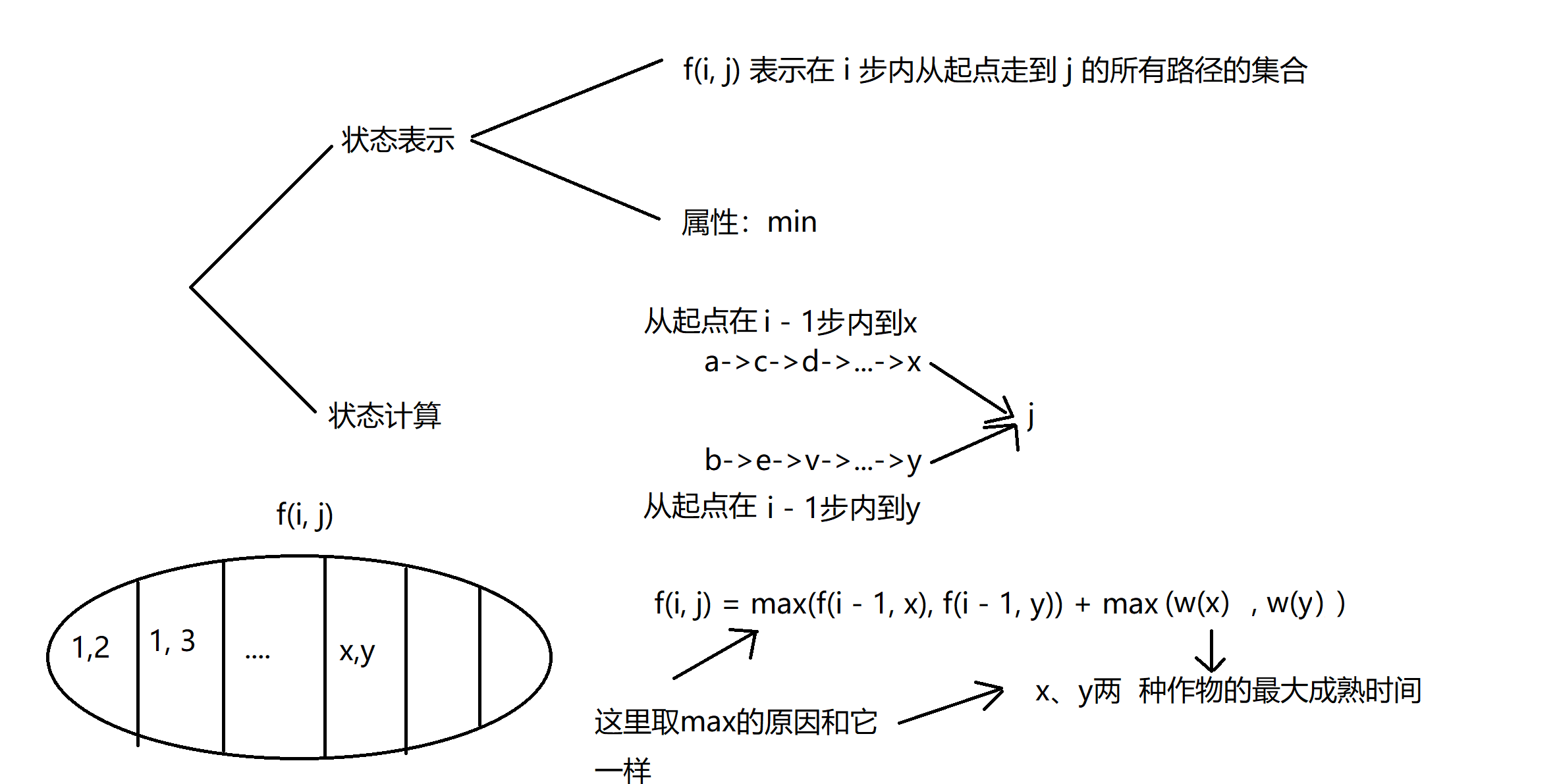3305. 作物杂交
思路
闫式 $DP$ 分析法:

当然如果是朴素地按照图中的状态转移方程,一共有 $n - 1$ 步,每一步最坏情况下需要从 $k$ 条边取一个 $max$,时间复杂度 $O(nk)$,会 $TLE$(即 $bellman-ford$ 算法的做法)。
如果用 $spfa$ 算法,那么我们只需要在 $x$ 被更新(就是在队列中的点,因为队列中存储的就是被更新距离的点)的时候,再取出能够和 $x$ 杂交的所有 $y$,然后更新 $x * y->z$ 这些边对应的终点 $z$ 的距离即可,时间复杂度优于 $O(nk)$(不过最坏情况也是 $O(nk)$)
当然代码实现上,我们仅仅使用一维数组 $f$ 存储所有距离即可。
如果担心 $spfa$ 被卡的话,因为边权都是正数,所以本题可以使用 $dijkstra$,朴素版 $O(n^2)$,堆优化版 $O(mlogn)$,在本题中都能过。这里给出堆优化版的代码。
spfa代码
#include <iostream>
#include <queue>
#define endl "\n"
using namespace std;
const int N = 2010, M = 200010;
const int INF = 0x3f3f3f3f;
int n, m, k, ed;
int e[M], ne[M], t[N], to[M], idx;
int f[N], h[N];
bool st[N];
queue<int> q;
void add(int x, int y, int z)
{
e[idx] = y, ne[idx] = h[x], to[idx] = z, h[x] = idx++;
}
void spfa()
{
while(q.size())
{
int x = q.front();
q.pop();
st[x] = false;
for(int i = h[x]; i != -1; i = ne[i])
{
int y = e[i], z = to[i];
if(f[z] > max(f[x], f[y]) + max(t[x], t[y]))
{
f[z] = max(f[x], f[y]) + max(t[x], t[y]);
if(!st[z]) q.push(z), st[z] = true;
}
}
}
}
int main()
{
ios::sync_with_stdio(false), cin.tie(0), cout.tie(0);
cin >> n >> m >> k >> ed;
for(int i = 1; i <= n; i++) h[i] = -1, f[i] = INF;
for(int i = 1; i <= n; i++) cin >> t[i];
while(m--)
{
int x;
cin >> x;
f[x] = 0;
q.push(x);
}
while(k--)
{
int x, y, z;
cin >> x >> y >> z;
add(x, y, z), add(y, x, z);
}
spfa();
cout << f[ed] << endl;
return 0;
}
堆优化版dijkstra
#include <iostream>
#include <queue>
#define x first
#define y second
#define endl "\n"
using namespace std;
const int N = 2010, M = 200010;
const int INF = 0x3f3f3f3f;
typedef pair<int, int> PII;
int n, m, k, ed;
int e[M], ne[M], t[N], to[M], idx;
int h[N], f[N];
bool st[N];
priority_queue<PII, vector<PII>, greater<PII>> q;
void add(int x, int y, int z)
{
e[idx] = y, ne[idx] = h[x], to[idx] = z, h[x] = idx++;
}
void dijkstra()
{
while(q.size())
{
PII cur = q.top();
q.pop();
int x = cur.y;
if(st[x]) continue;
st[x] = true;
for(int i = h[x]; i != -1; i = ne[i])
{
int y = e[i], z = to[i];
if(f[z] > max(f[x], f[y]) + max(t[x], t[y]))
{
f[z] = max(f[x], f[y]) + max(t[x], t[y]);
q.push({f[z], z});
}
}
}
}
int main()
{
ios::sync_with_stdio(false), cin.tie(0), cout.tie(0);
cin >> n >> m >> k >> ed;
for(int i = 1; i <= n; i++) h[i] = -1, f[i] = INF;
for(int i = 1; i <= n; i++) cin >> t[i];
while(m--)
{
int x;
cin >> x;
f[x] = 0;
q.push({f[x], x});
}
while(k--)
{
int x, y, z;
cin >> x >> y >> z;
add(x, y, z), add(y, x, z);
}
dijkstra();
cout << f[ed] << endl;
return 0;
}

